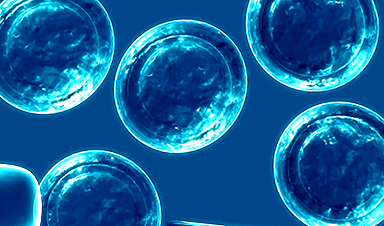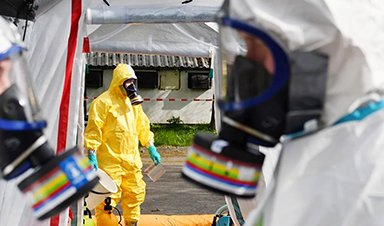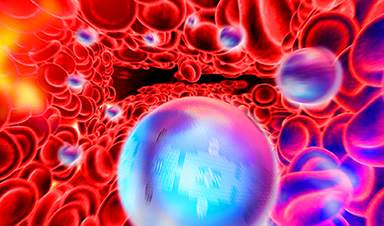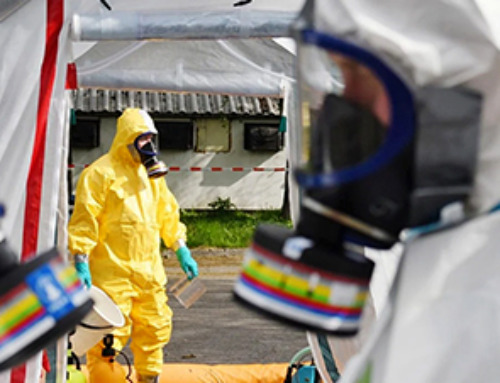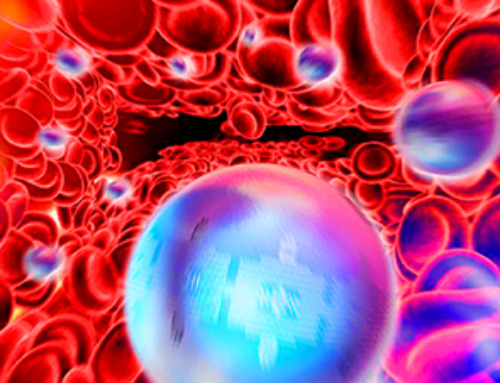Hydrogels have gained widespread recognition and utilization in biomedical engineering, with their applications dating back to the 1960s when they were first used in contact lens production.
Hydrogels are distinguished from other biomaterials in biomedical applications because of their remarkable flexibility and versatility. Owing to these advantageous properties, they find applications across a wide spectrum, ranging from industrial to biological applications.2
A Brief Overview of the Hydrogel Structure and Properties
Hydrogels are characterized by their hydrophilic nature and 3D network structure, possessing the unique ability to absorb significant amounts of water or biological fluids. This feature makes them ideal candidates for various biomedical applications, including biosensors, drug delivery systems, and carriers or scaffolds for cells in tissue engineering.3
In biomedical applications, the similarity between the physical attributes of hydrogels and human tissues, along with their tunable physiochemical properties, makes them a popular choice. They also offer the potential for functionalization.
Common applications of hydrogels include medical patches, tissue sealants, drug carriers, and flexible electronic devices.4
Hydrogel properties, including swelling and deswelling rates, matrix stiffness, degradability, and mesh size, can be adjusted to suit specific biomedical applications. This adjustment is achieved by altering the hydrophilic-hydrophobic ratios and reaction rates, making them popular for various biomedical purposes.5
Traditionally, hydrogels have been made using a controlled batch reactor chamber manufacturing process. This conventional process involves combining reactants in a reactor where the mixture undergoes thorough blending at a specified stir rate and temperature.
Once the chemicals form a slurry, they are combined with other pre-prepared solutions under specified conditions. This process yields a hydrogel with the high-strength properties required for biomedical applications.6
Additive manufacturing techniques, such as bio-ink-based 3D printing, have revolutionized the production of hydrogels. They significantly reduce manufacturing time and allow for the precise control of structural attributes.
Applications of Hydrogels in Biomedicine
In the biomedical field, hydrogels are a popular choice for drug delivery systems, wearable sensors, the manufacturing of tissue scaffolds, and anti-microbial bandages and wound dressings.
In cell culture, 3D cell cultures offer a valuable platform for cell growth in vitro, enabling growth in all directions. Unlike the 2D culture system, 3D cultures facilitate a better understanding of in vivo cell behavior as cells develop into a 3D structure akin to living tissue.
This is achieved by culturing cells on a 3D scaffold, mimicking the natural 3D cell structures found in vivo, where cells are embedded in the extracellular matrix (ECM) and form a 3D network.
Hydrogels possess a 3D structure and a hydrophilic polymer network capable of absorbing water and biological fluids, allowing them to construct soft and wet 3D structures.7 Natural hydrogels, in particular, exhibit good biocompatibility, contain endogenous factors, and possess viscoelasticity and fibrils similar to the ECM.
Many natural materials, such as chitosan, are used to develop hydrogels, but a very widely used substance is Hyaluronic acid (HA). HA is a natural hydrogel material and a major component of the ECM. This molecule is found in different essential tissues, such as skin and cartilage.
Another natural source is fibrin, with fibrin hydrogel essential to ECM development. Fibrin hydrogel has various customizable properties that can be optimized for modern tissue engineering and stem cell cultivation.8
Smart hydrogels, made from naturally occurring polymeric materials, are also being investigated for use in targeted cell delivery. Their responses are highly dependent on external stimuli, promoting their use in the development of targeted drugs and intricately controlled release of medicinal substances, especially cancer drugs, without injecting any substance into the human veins.9
Self-healing hydrogels (SHHs) have recently gained attention, as their properties closely resemble human muscles and natural tissues. The innate ability of natural tissues to self-heal is fascinating, extending their longevity while enhancing strength and durability.
The striking similarities between self-healing hydrogels and natural tissues make them suitable for real-time applications in diverse areas such as soft robotics, drug delivery, and carrier systems for transporting various molecules within cells.10
Wound healing is a multifaceted and complex process involving the repair of damaged tissue layers and cellular structures. SHH compounds have the potential to reduce the frequency of dressing changes and, therefore, any unnecessary discomfort for patients. They also fulfill the requirements for surgical debridement, especially for burn patients.11
Artificial Intelligence-Based Innovation in Hydrogel Design and Optimization
Previously, the development of hydrogels followed a series of lengthy experiments, and their optimization could take years, leading to significant financial losses and time wastage.
Recently, the application of computer simulations and modern technologies has revolutionized material science and engineering. The use of artificial Intelligence (AI) in the design and development of modern hydrogels has boosted the industrialization of these substances.
AI-energized hydrogel design utilizes machine learning (ML) algorithms to analyze extensive datasets and pinpoint the most effective combinations of polymers, cross-linking agents, and additives for producing hydrogels with precise properties.
This approach enables researchers to rapidly design and optimize hydrogels tailored to specific requirements, including mechanical strength, porosity, biocompatibility, and drug release profiles.
With the aid of AI, hydrogels have seen enhanced applications in tissue engineering, including drug delivery, bio-inks for advanced manufacturing, tissue repair, and biosensors.12
The advancement of AI-energized multifunctional hydrogel products is still in its early phases. Implementing AI necessitates extensive datasets for training, validation, and testing.
For example, in the development of hydrogel drug delivery systems, it is crucial to adjust input parameters effectively and possess comprehensive data on hydrogel release outcomes.
Access to ample experimental data, encompassing both input parameters and release outcomes, would greatly aid in refining predictive models and understanding the underlying relationships.
Latest Development in Hydrogel Based Solutions for Cardiac Treatment
In a recent development, scientists at the University of Waterloo have introduced a novel hydrogel designed to repair injured heart tissue and enhance cancer therapies.
This synthetic substance is crafted from cellulose nanocrystals extracted from wood pulp. It is engineered to mimic the fibrous nanostructures and characteristics of human tissues, reproducing the distinctive biomechanical attributes of natural tissues.
The same department is also leading the development of similar biomimetic hydrogels suitable for drug delivery and regenerative medicine applications, focusing on creating injectable formulations.
Hydrogels hold tremendous potential in the medical field due to their rapid and effective bonding capabilities. These gel-like materials, which can be tailored to have varying levels of stiffness, enable the mimicry of the mechanical properties of specific tissues.
To further improve the efficiency of hydrogels, it is imperative to address cost challenges, develop sustainable production techniques, and integrate digital technologies.
References and Further Reading
[1] Xiao, Z. et al. (2022). Adhesion mechanism and application progress of hydrogels. European Polymer Journal. doi.org/10.1016/j.eurpolymj.2022.111277
[2] Mahmood, A. et al. (2022). Recent Progress in Biopolymer-Based Hydrogel Materials for Biomedical Applications. International Journal of Molecular Sciences. doi.org/10.3390/ijms23031415
[3] Li, W. et al. (2022). Bio‐inspired adhesive hydrogel for biomedicine—principles and design strategies. Smart Medicine. Available at: doi.org/10.1002/SMMD.20220024
[4] Hua, M. et al. (2021). Strong tough hydrogels via the synergy of freeze-casting and salting out. Nature. doi.org/10.1038/s41586-021-03212-z
[5] Liu, T. et al. (2021). Effect of freezing process on the microstructure of gelatin methacryloyl hydrogels. Frontiers in Bioengineering and Biotechnology. doi.org/10.3389/fbioe.2021.810155
[6] Ahmed, EM. (2015). Hydrogel: Preparation, characterization, and applications: A review. Journal of advanced research. doi.org/10.1016/j.jare.2013.07.006
[7] Park, Y., et al. (2022). Applications of Biomaterials in 3D Cell Culture and Contributions of 3D Cell Culture to Drug Development and Basic Biomedical Research. International Journal of Molecular Sciences. doi.org/10.3390/ijms22052491
[8] Heo, D., et al. (2019). Synergistic interplay between human MSCs and HUVECs in 3D spheroids laden in collagen/fibrin hydrogels for bone tissue engineering. Acta biomaterialia. doi.org/10.1016/j.actbio.2019.02.046
[9] Chung, T., et al. (2021). Developing photothermal-responsive and anti-oxidative silk/dopamine nanoparticles decorated with drugs which were incorporated into silk films as a depot-based drug delivery. International Journal of Biological Macromolecules. doi.org/10.1016/j.ijbiomac.2021.06.084
[10] Rumon M. et al. (2022). Self-Healing Hydrogels: Development, Biomedical Applications, and Challenges. Polymers. doi.org/10.3390/polym14214539
[11] Hasan, M., et al. (2021). Fabrication and characterization of chitosan-polyethylene glycol (Ch-PEG) based hydrogels and evaluation of their potency in rat skin wound model. International Journal of Biomaterials. doi.org/10.1155/2021/4877344
[12] Li, Z. et al. (2024). AI energized hydrogel design, optimization and application in biomedicine. Materials Today Bio. doi.org/10.1016/j.mtbio.2024.10101
News
Fever-Proof Bird Flu Variant Could Fuel the Next Pandemic
Bird flu viruses present a significant risk to humans because they can continue replicating at temperatures higher than a typical fever. Fever is one of the body’s main tools for slowing or stopping viral [...]
What could the future of nanoscience look like?
Society has a lot to thank for nanoscience. From improved health monitoring to reducing the size of electronics, scientists’ ability to delve deeper and better understand chemistry at the nanoscale has opened up numerous [...]
Scientists Melt Cancer’s Hidden “Power Hubs” and Stop Tumor Growth
Researchers discovered that in a rare kidney cancer, RNA builds droplet-like hubs that act as growth control centers inside tumor cells. By engineering a molecular switch to dissolve these hubs, they were able to halt cancer [...]
Platelet-inspired nanoparticles could improve treatment of inflammatory diseases
Scientists have developed platelet-inspired nanoparticles that deliver anti-inflammatory drugs directly to brain-computer interface implants, doubling their effectiveness. Scientists have found a way to improve the performance of brain-computer interface (BCI) electrodes by delivering anti-inflammatory drugs directly [...]
After 150 years, a new chapter in cancer therapy is finally beginning
For decades, researchers have been looking for ways to destroy cancer cells in a targeted manner without further weakening the body. But for many patients whose immune system is severely impaired by chemotherapy or radiation, [...]
Older chemical libraries show promise for fighting resistant strains of COVID-19 virus
SARS‑CoV‑2, the virus that causes COVID-19, continues to mutate, with some newer strains becoming less responsive to current antiviral treatments like Paxlovid. Now, University of California San Diego scientists and an international team of [...]
Lower doses of immunotherapy for skin cancer give better results, study suggests
According to a new study, lower doses of approved immunotherapy for malignant melanoma can give better results against tumors, while reducing side effects. This is reported by researchers at Karolinska Institutet in the Journal of the National [...]
Researchers highlight five pathways through which microplastics can harm the brain
Microplastics could be fueling neurodegenerative diseases like Alzheimer's and Parkinson's, with a new study highlighting five ways microplastics can trigger inflammation and damage in the brain. More than 57 million people live with dementia, [...]
Tiny Metal Nanodots Obliterate Cancer Cells While Largely Sparing Healthy Tissue
Scientists have developed tiny metal-oxide particles that push cancer cells past their stress limits while sparing healthy tissue. An international team led by RMIT University has developed tiny particles called nanodots, crafted from a metallic compound, [...]
Gold Nanoclusters Could Supercharge Quantum Computers
Researchers found that gold “super atoms” can behave like the atoms in top-tier quantum systems—only far easier to scale. These tiny clusters can be customized at the molecular level, offering a powerful, tunable foundation [...]
A single shot of HPV vaccine may be enough to fight cervical cancer, study finds
WASHINGTON -- A single HPV vaccination appears just as effective as two doses at preventing the viral infection that causes cervical cancer, researchers reported Wednesday. HPV, or human papillomavirus, is very common and spread [...]
New technique overcomes technological barrier in 3D brain imaging
Scientists at the Swiss Light Source SLS have succeeded in mapping a piece of brain tissue in 3D at unprecedented resolution using X-rays, non-destructively. The breakthrough overcomes a long-standing technological barrier that had limited [...]
Scientists Uncover Hidden Blood Pattern in Long COVID
Researchers found persistent microclot and NET structures in Long COVID blood that may explain long-lasting symptoms. Researchers examining Long COVID have identified a structural connection between circulating microclots and neutrophil extracellular traps (NETs). The [...]
This Cellular Trick Helps Cancer Spread, but Could Also Stop It
Groups of normal cbiells can sense far into their surroundings, helping explain cancer cell migration. Understanding this ability could lead to new ways to limit tumor spread. The tale of the princess and the [...]
New mRNA therapy targets drug-resistant pneumonia
Bacteria that multiply on surfaces are a major headache in health care when they gain a foothold on, for example, implants or in catheters. Researchers at Chalmers University of Technology in Sweden have found [...]
Current Heart Health Guidelines Are Failing To Catch a Deadly Genetic Killer
New research reveals that standard screening misses most people with a common inherited cholesterol disorder. A Mayo Clinic study reports that current genetic screening guidelines overlook most people who have familial hypercholesterolemia, an inherited disorder that [...]
